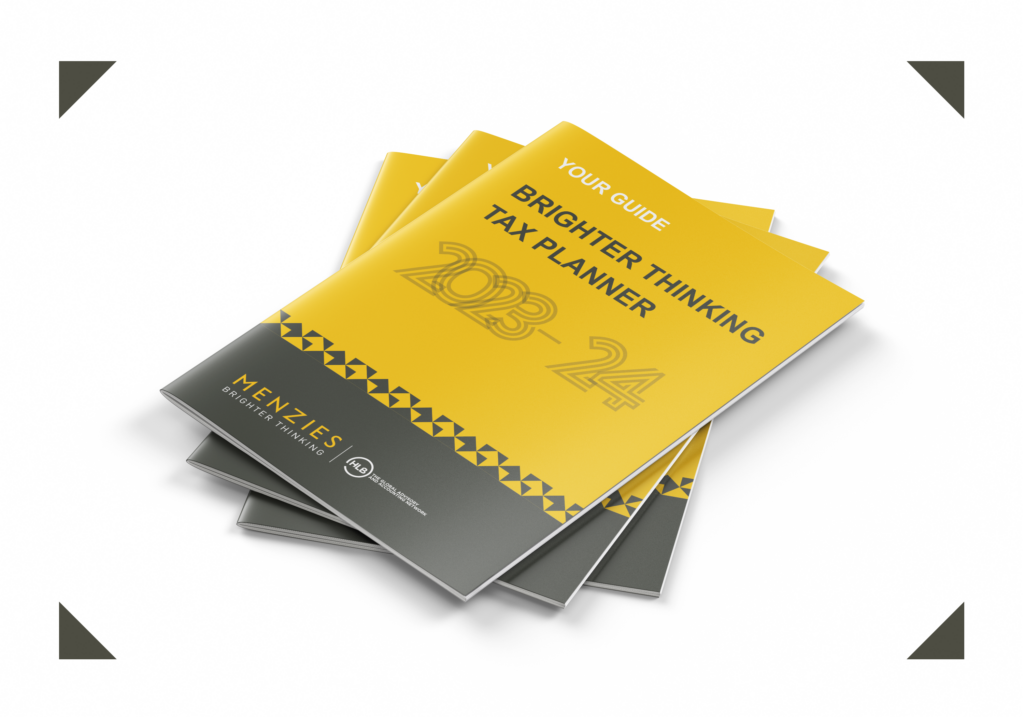The most common form of taxation for individuals is income tax, and the rates applied can be punitive. However, there are still strategies available which can eat away at the amount of income tax to which you would otherwise be liable.

Download our Brighter Thinking Tax Planner
#
Income tax rates bands
For background, the amount of income tax you pay is determined by the quantum of your taxable income. The current rate bands for income tax are as follows:
| Income | First £37,700 | £37,701- £150,000 | Over £150,000 |
| Rate | 20% | 40% | 45% |
The Chancellor announced in his Autumn Statement that the top rate of tax threshold will be cut from £150,000, down to £125,140 from April 2023. Therefore, you will start to pay the top rate of income tax sooner going forward. Spouses are taxed independently (when any reference is made to spouses or married couples, this also includes civil partnerships).
Your #BrighterThinking next steps
“Consider making use of lower rate tax bands, and review tax implications of transferring income producing assets, but taking note of anti-avoidance and settlements legislation. This is more important than ever with the highest rate of tax kicking in at a lower level of income.”
David Truman – Private Client Partner
Married Couples
Married couples should utilise each person’s personal reliefs, as well as their starting and basic rate tax bands.
It may be beneficial to consider gifts of income producing assets (which must be outright and unconditional) to distribute income more evenly between spouses.
For example: a saving of up to £15,000 in income tax per tax year could be achieved by the transfer of assets (that produce £50,000 of income per year) from an additional rate (45%) taxpayer to their non-earning spouse.
Income from jointly owned assets is generally shared equally for tax purposes. This applies even where the asset is owned in unequal shares unless an election (that needs to be filed with HM Revenue and Customs), is made to split the income in proportion to the ownership of the asset. Without the election being filed, the income will automatically be split 50:50. When the circumstances fit, we can assist with the advice and an election.
Personal Allowance

The first £12,570 of a taxpayer’s income is generally tax free by virtue of the personal
allowance. It is important for individual taxpayers to make use of the personal allowance each tax year because it cannot be carried forward. The Chancellor has confirmed that the personal allowance will be frozen at this rate until April 2028.
Where you are a basic rate taxpayer and your spouse does not pay any tax, it should be possible to transfer an element of the personal allowance. To action this, it is necessary to complete a specific claim – something that Menzies can manage on your behalf.
For those with incomes in excess of £100,000, the personal allowance (of £12,570) begins to be withdrawn at a rate of £1 for every £2 of income above £100,000. The impact is punitive with a 60% effective tax rate for income between £100,000 and £125,140.
Additionally, those with incomes of over £150,000 (£125,140 from 6 April 2023) will be subject to the additional rate of tax (45%).
In these instances, you may wish to consider if there are any income tax deductions which can be claimed to reduce your income. These could include donations under Gift Aid, transferring income to others or by making pension contributions. You may wish to consider accelerating the receipt of income in the current year, ahead of the change in thresholds.
Your #BrighterThinking next steps
“Where a spouse does not use all of their personal allowance, consider electing to transfer an element to the other spouse to reduce the family’s tax burden. Review any restrictions of allowances with a view to adjusting taxable income for the next tax year, and preservation of the personal allowance. This will become increasingly important with the freezing of allowances and reduction in the additional rate threshold.
Individuals with income around the £100,000 mark may also consider making pension contributions to regain their personal allowance or ‘wrapping’ any income producing assets within a more tax efficient investment structure such as an ISA or investment bond.”
Helen Cuthbert – Private Client Director
Dividend nil rate band
The first £2,000 (reducing to just £1,000 from April 2023 and further reduced to £500 from April 2024) of dividend income received in the tax year is FREE of income tax. Dividends received over and above the £2,000 (and reduced £1,000 and £500) tax free dividend allowance are subject to their own tax rate bands:
Basic rate – 8.75%%
Higher rate – 33.75%
Additional rate – 39.35%
These rates were increased by 1.25% for 2022/2023 as part of the package of measures to fund social care and the NHS and the same rates will apply for 2023/24.
If you own shares in a family company, you may wish to consider who else in your family could have shares. It is possible to have different shares issued with different rights (e.g. dividend only shares or non-voting shares). Be warned as careful planning is required to ensure you do not fall foul of the HMRC anti avoidance regulations.
Your #BrighterThinking next steps
“Try and make use of the dividend nil rate band and consider whether any dividends should be advanced pre-April 2023 to mitigate the impact of the reduction in the top rate threshold to £125,140. Also consider declaring a dividend where the taxpayer is a shareholder in a family company and not fully utilising their basic rate tax band for the current tax year.”
Andrew England – Corporate Tax Partner
Personal Savings Allowance
For basic rate taxpayers, there is a savings nil rate band of £1,000, which means the first £1,000 of savings income is taxed at 0%.
For higher rate taxpayers, the savings rate band is £500, and for additional rate taxpayers (i.e. taxable income over £150,000 (£125,140 from April 2023) it is withdrawn altogether.
The savings nil rate band is not transferable between spouses, so it is important to ensure that bank accounts are held to maximise the nil rate band.
Your #BrighterThinking next steps
“Don’t forget to make use of your spouse’s Personal Savings Allowance. You could do this by electing to transfer savings held in your own name to your spouse. Even though this has been reduced, it will still cover many family circumstances.”
David Truman – Private Client Partner
The starting rate for savings

Where a taxpayer has relatively modest non-savings income (e.g. employment, pension or income from property), they may be entitled to the £5,000 starting rate for savings allowance making this income tax free.
The starting rate for savings applies before the nil rate band. By careful planning – and where you have your own company – you could hypothetically extract £20,570 (£19,570 from April 2023 and £19,070 from April 2024) tax free, which can be broken down as follows:
- Personal allowance – £12,570
- Starting rate for savings – £5,000
- Savings nil rate band – £1,000
- Dividend allowance – £2,000 (reducing to £1,000 from April 2023 and down to £500 from April 2024)
When considering profit extraction, timing is critical as it can have significant consequences on what tax is payable and when. We would strongly recommend seeking professional advice as there could be merit in deferring income to a later year.
Your #BrighterThinking next steps
“Utilise the 0% Starting Rate for Savings on the first £5,000 of income where appropriate. For those who have a family company, carefully consider the profit extraction techniques, with a view to tax efficiency.”
Craig Hughes – Private Client Partner
Allowances – Children
Children have their own allowances and tax bands. It may be possible for tax savings to be achieved by the transfer of income producing assets to a child.
Generally, this is ineffective if the parent puts aside funds for their minor child (as the income remains taxable on the parent unless the income arising amounts to no more than £100 gross per annum). However, it may be relevant to parents with adult children or for grandparents who wish to make gifts to their grandchildren (even if minors). Bare Trusts could be established to provide for grandchildren’s childcare and schooling costs, making use of the grandchildren’s own income tax and capital gains tax allowances.
Your #BrighterThinking next steps
“In any family structure, consider how to make use of children’s allowances, both for income tax and capital gains tax purposes.”
Helen Cuthbert – Private Client Director
Child benefit tax charge
For those with income over £50,000, or who are part of a couple where one of you earns over £50,000, then part or all of the Child Benefit claimed will be clawed back.
If your income is over £60,000 you may therefore consider disclaiming Child Benefit to avoid a claw back tax charge. However, if the claimant of child benefit is not themselves working, then disclaiming it will mean the year does not qualify for State Pension purposes. In this scenario you should just ask for payment to be stopped rather than disclaiming it altogether.
Your #BrighterThinking next steps
“Does someone in your household receive Child Benefit, and you earn more than £50,000 per annum? If so, you may need to repay an element of the Child Benefit to HMRC. Should you earn over £60,000, consider the merits of pausing Child Benefit payments.”
Mike Ward – Private Client Director
PAYE notices of coding

Where you are employed, or have a pension, it is worth checking your PAYE Notice of Coding to ensure your allowances are correctly stated. This includes relief for pension contributions, charitable donations and any other tax reliefs.
HMRC’s coding system has, in our experience, led to many incorrect coding notices. If the coding is wrong, many taxpayers could end up with an unwanted, and unexpected, tax bill after the end of the tax year. If you’re in any doubt then Menzies can review your PAYE Notice of Coding to ensure it is reasonable and in line with your income.
Your #BrighterThinking next steps
“Where you are issued with a new PAYE Notice of Coding ensure you check it to ensure it includes the correct allowances and restrictions. Notify HMRC of any changes required.”
David Truman – Private Client Partner
Property

In recent years, the Chancellor of the Exchequer has targeted individuals with second properties, and specifically buy-to-let landlords. This has included the introduction of increased Stamp Duty Land Tax (SDLT), the restriction on expenses which can be set against rental profits and a hike in capital gains tax rates.
Probably the most controversial was the introduction (from 6 April 2017) of the finance costs restriction. Where it was previously possible to claim 100% tax relief on the finance costs of any loan associated with the rental, this has now been replaced by a tax reducer. Items which are included under finance costs include mortgages, loans (including loans to buy furnishings) and overdrafts.
From the 2020/21 tax year onwards, the restriction has meant 100% of the total finance cost being claimed as a tax reducer rather than an expense. This reducer is given in the form of a 20% reduction based on the lower of: the finance cost; property profits or adjusted total income exceeding the personal allowance. Therefore, individuals with one or more buy-to-let properties may need to review their position and consider the initial and long-term impacts this may have on their property income and tax liability.
For those who have significant rental property businesses which are not currently structured as a company, there may be merit in considering incorporation. We can quantify the advantages and disadvantages and implement the appropriate structure. There is, however, light at the end of the tunnel and some tax breaks still available. For example, if you rent a room in your main residence, the first £7,500 in rental income is tax free. This is called the “rent a room” allowance, and where you own a property jointly, the allowance is split.
Finally, if you have a Furnished Holiday Letting (FHL), you may qualify for some generous tax breaks, including obtaining full tax relief for interest on loans attached to the property, and a capital gains tax rate of 10% on eventual sale. Specific conditions need to be satisfied to qualify as a FHL, and professional advice is strongly recommended. Should you wish to pursue one or all of these property tax breaks, an informal discussion with one of our specialist property team members is a great first step to understand what opportunities may be available and your immediate next steps.
Those looking to sell UK residential property should take advice on the reporting requirements “in year” as Capital Gains Tax Property Returns must be filed within 60 days of completion. For UK residents there is a get out where the disposal does not give rise to a capital gain, but all non-UK resident owners making a residential property disposal will need to file.
Stamp duty land tax
The starting nil rate band for SDLT will remain at £250,000 and it was announced in the Autumn Statement that this temporary change to the SDLT band will end on 31 March 2025. First time buyer’s relief from SDLT covers the first £425,000 of purchase price and it is not clear if this increase to the relief for first time buyers will remain in place permanently.
A 2% SDLT surcharge was introduced for non resident buyers of UK residential property, from 1 April 2021.
The 3% surcharge on the purchase of additional properties applies at all times.
Your #BrighterThinking next steps
“Where you have loans attached to rental properties, check whether restructuring is appropriate to maximise tax reliefs. Establish a tax reserve or buffer to account for the additional income tax for buy to-let property as a result of the rule changes. If you have a buy-to-let property, or properties, consider through which vehicle you should hold them. For example, in your own name, as a couple, a partnership or a company. Should you have a Furnished Holiday Let, check you are happy all the appropriate conditions have been satisfied to ensure it qualifies for the appropriate tax breaks.”
David Truman – Private Client Partner
Gifts to charity

Charitable donations made under the Gift Aid scheme can result in significant benefits for both the donor and the charity. It is important to keep a record of any charitable payments on which you wish to claim tax relief, as HMRC may request evidence.
A cash gift of £80 will generate a tax refund of £20 for the charity so that it ends up with £100. The donor will get higher rate tax relief of £20 so that the net cost of the gift is only £60. Where the 45% additional rate of tax applies, the net cost of the gift in this example would be only £55.
Care needs to be taken in claiming gift aid if you are a low earner and can create an unexpected tax charge if you gift funds which fall within your personal income tax allowance.
In addition, tax relief against 2022/23 income is possible for charitable donations made between 6 April 2023 and 31 January 2024. This is provided that the payment is made before filing the 2022/23 tax return. That said, you may wish to defer making significant charitable donations until the 2023/24 tax year where you will now be an additional rate taxpayer due to the threshold changes.
For larger charitable donations, it may also be possible to make gifts of quoted shares and securities or land and buildings to charities and claim income tax relief on the value of the gift.
Your #BrighterThinking next steps
“Keep a record of any gift aid payments to ensure you claim the tax relief to which you are entitled. If any gift aid payments are to be made post 6 April 2022, but before filing your 2021/22 tax return with HMRC, consider whether to treat the payment in the earlier tax year to accelerate any further tax relief.”
David Truman – Private Client Partner
Menzies Private Client Team

Personal tax planning can be complex. We would always recommend that you seek professional advice when undertaking a review to ensure all changes are processed and managed effectively. Please do speak with your Menzies contact who will be delighted to meet with you to discuss ideas, opportunities and the appropriate action.
To discuss your income tax planning arrangements for the tax year ahead, contact Menzies Private Client Team below: